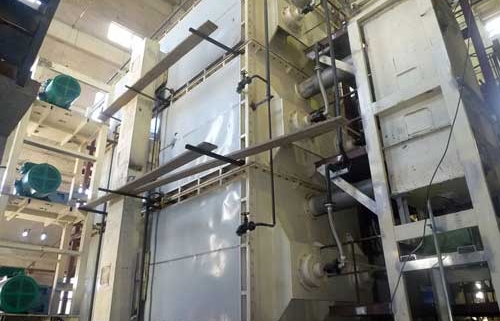The hollow blade dryer consists of two blade shafts that mesh with each other, a W-shaped casing with a jacket, a machine base and a transmission part. The entire drying process of the sludge is carried out in a closed state, and the organic volatile gas and the odor gas are It is sent to the exhaust gas treatment device in a sealed atmosphere to avoid environmental pollution.
The dryer uses steam, hot water or heat transfer oil as the heating medium, and the shaft end is equipped with a rotary joint for introducing and exporting the heat medium. The heating medium is divided into two paths, respectively entering the jacket of the dryer casing and the inner cavity of the blade shaft, heating the body and the blade shaft at the same time, and heating and drying the sludge by conduction heating.
The dried material is continuously and continuously fed into the dryer feeding port by the screw feeder. After the material enters the blade, the material is turned and stirred by the rotation of the blade, and the heating interface is continuously changed, and the body and the blade are in contact with each other. Heating to evaporate the surface moisture contained in the sludge. At the same time, the material is conveyed in the direction of the discharge port with the rotation of the blade shaft in a spiral path, and the stirring is continued during the transportation, so that the water oozing out from the sludge continues to evaporate. The uniformly dried product is then discharged from the discharge port.
Features
1. The equipment is compact in structure and the device covers a small area. It can be seen from the structure of the device that the heat required for drying is mainly provided by the hollow blade wall surface arranged on the hollow shaft, and the heat transfer amount of the jacket wall surface is only a small part. Therefore, the heat transfer area per unit volume of equipment is large, which can save equipment footprint and reduce capital investment;
2. High heat utilization rate. The paddle dryer is heated by conduction heating, and all heat transfer surfaces are covered by materials, which reduces heat loss; no air takes away heat, and the heat utilization rate can reach 80% or more;
3. The wedge-shaped blade has self-cleaning ability, which can improve the blade conduction. The dispersing force generated by the combined movement of the inclined surface of the rotating blade and the particle or powder layer causes the material attached to the heating ramp to be automatically removed, and the blade maintains an efficient heat transfer function. In addition, due to the reverse rotation of the two-axis blades, the alternating section compression (when the two-axis blade faces are close together) and the expansion (when the two-axis blade faces are far apart), the heat transfer is uniform and the heat transfer is uniform. Heat transfer effect;
4. Since no gas is needed for heating, only a small amount of gas is needed to take away the humid air. The gas velocity in the dryer is low, and the dust emitted by the gas is less, and the gas dust recovery of the system after drying is convenient;
5. The material moisture content has wide adaptability and the product has uniform drying uniformity. The dryer is provided with an overflow weir, which can adjust the residence time of the material in the dryer according to the nature of the material and the drying conditions to meet the requirements of the moisture content change of the material. In addition, the feed rate, the rotational speed of the shaft, and the temperature of the heat carrier can be adjusted, and the residence time can be arbitrarily selected between several minutes and several hours. Therefore, the adaptability to the change of moisture content of materials is very wide;
6. The feeding adopts the shaftless screw conveyor, which can transport the muddy materials with high viscosity and high moisture content;
When selecting a paddle dryer, the following factors are mainly considered.
1. Heat source, heat transfer medium and heat loss
The expenditure on drying heat accounts for 60% to 75% of the operating cost of the drying system, or even higher. Therefore, the study of heat source selection and reduction of heat loss is the top priority for the evaluation of the blade dryer drying system.
2. Security
A certain amount of dust will be generated during the hot drying process of the sludge. When the dust reaches a certain concentration, and the oxygen content and temperature are satisfied, explosion or deflagration may occur. Dust explosion accidents are not uncommon at home and abroad, and should be given enough attention.
3. Impact on the environment
In the process of drying, the sludge not only produces odorous gases such as ammonia gas and hydrogen sulfide, but also toxic substances such as benzene, phenol and corresponding compounds. In the process design, the volatilization of these substances should be reduced as much as possible, and the volatilized gas should be properly disposed to avoid gas leakage.



